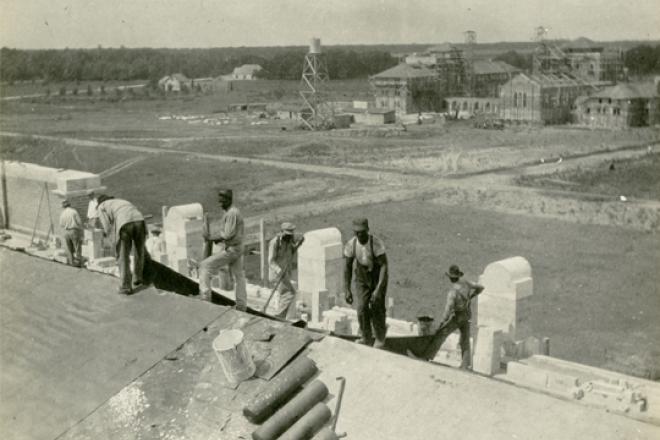Behind a corner gas station and in the shadow of luxury apartments sits one of the finest buildings in Houston, falling into disrepair. Designed by Alfred C. Finn and completed in 1925, the Houston Light Guard Armory building has been abandoned for quite some time. Vagrants and vandals have had their say, as well as Gulf Coast weather and its most recent envoy, Hurricane Ike. The history of the building is regrettably full of misfortune. After only 13 years of service to the Houston Light Guard, the armory was deeded to the state. Attempts to rescue the building have come in fits and starts, so far without success.
The Buffalo Soldiers National Museum has plans to restore the Armory and give it a purpose that relates to its original use.
This young non-profit, founded in 2000, began with the private collection of Captain Paul Matthews’s memorabilia and is rapidly expanding beyond the confines of their current residence on Southmore. As the only nationally recognized museum celebrating the African-American soldier it is poised to become a national destination.

The Buffalo Soldiers have a long and difficult past. The term itself began as a Native American description of these men’s bravery, was later used as a term of derision in newly desegregated units, and then embraced again as a symbol of selfless sacrifice and courage. As Chief Docent and Historian Richard Barefield exclaimed, “this is not black history, this is American history,” this is our history.
Mr. Barefield met me at the Armory to present their vision for the building. Circling the exhibition space, vaulted by steel trusses rapidly approaching 100 years old, he described the scores of African-American heroes from 1866 to present day. Gaps between plywood and brick openings give a hint to the daylight that will flood this grand hall. Ceremonial stairs, as all ambitious buildings once had, lead from grand double doors past anterooms with empty fireplaces. One will become a multi-media theater, the other a greeting area and gift shop. Even through the dust, these rooms evoke the stately air that we all share in our visions of the past.

As we delved further it was clear the simple rectilinear mass of the Armory building belies the complexity of the nested interior. The simple span of the open exhibition space is plainly the show-stopper, but the secondary rooms are nearly as exciting to explore. A stair branches off the formal entry and with a Loos-ian turn tucks an ideal office and conference space above, overlooking future exhibits. Two further flights are secreted to descend back to the ground level inside the building. Here concrete columns support the floor above and will become the boundaries for a reference library, coffee shop, and adjacent learning space of the Houston Community College. Service doors are to be retrofitted as the primary entry to the museum, addressing Alabama Street to the North.
The lively Sergeant Major James Williams joined Mr. Barefield and me for the last leg of the tour. As measuring tapes straddled across empty windows in anticipation, both men shared their hopes that this institution would “saturate the neighborhood” and teach the youth. Their goal is to see history brought up to date, that these soldiers are given “recognition not [yet] received.” Both building and soldier have a past that has been shamefully neglected. In the establishment of this new vision, I can think of no more fitting pair.
Renovations of the Houston Light Guard Armory are estimated at upwards of $4 million dollars. Though initial clean-up and minor demolition is getting underway the Buffalo Soldier National Museum is a far cry from reaching their goal. You can make your contribution to the reconstruction effort at: www.supportbsnm.org
The Buffalo Soldier National Museum is a 501(c)(3) charitable organization.
Ready and Forward.










